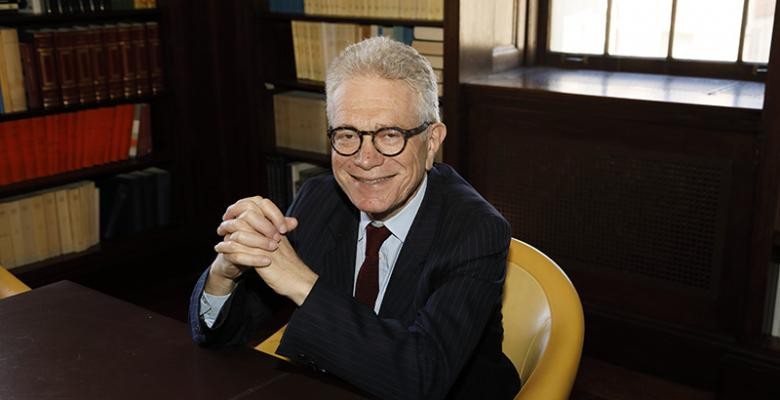David Freedberg Uses Neuroscience to Shed Light on Responses to Art

Since leaving his native South Africa in 1966 to attend Yale and, later, Oxford, David Freedberg’s art historical interests have spanned the globe as much as he has.
He arrived at Columbia in 1986 to teach Dutch and Flemish art, but the subjects he has studied include 17th-century Roman art, the paintings of French baroque artist Nicolas Poussin, the contemporary American conceptual artist Joseph Kosuth and the architecture and dance of Native American Pueblo peoples.
Freedberg, the Pierre Matisse Professor of the History of Art and director of Columbia’s Italian Academy, reads in nine languages and speaks fluently in five. He expanded the definition of art history by arguing in his 1989 book, The Power of Images: Studies on the History and Theory of Response, that responses to art are their own form of history. He proposed expanding the discipline beyond a progression of styles and the social context of cultural artifacts to embrace relevant fields such as psychology and anthropology.
Freedberg’s interest in psychological responses to art focuses in particular on iconoclasm and censorship, phenomena much in evidence in the late 1980s, when statues and monuments were being destroyed in former Communist regimes, while in the United States, Richard Serra’s controversial sculpture Tilted Arc was removed from a plaza in front of a Manhattan federal building and a Washington gallery cancelled a traveling exhibition of Robert Mapplethorpe’s photographs, some of them sexually explicit. Debates about public funding of the arts and censorship continue to this day.
Interactive Slideshow
Such issues have been raised again amid the discussion of what to do about Confederate monuments. “Every act of censorship is also an act of iconoclasm, and together they constitute one of the oldest paradoxes of image-making,” Freedberg said. “More often than not iconoclasm shows why images—and art— matter to people. Otherwise why bother to attack images, why smash them as if to demonstrate one’s power over things that are dead pieces of wood and stone?”
In the 1990s, after functional magnetic resonance imaging and other new techniques began mapping brain activity, Freedberg started working with neuroscientists to learn more about the relationship between vision, motion and empathy.
“I’m not focused on how people make things, but how people respond to things,” said Freedberg. “How does the brain react to art? Why are we attracted or repelled by it? This gets to the very core of what makes us human.”
It took some convincing to persuade other art historians of his view. “They felt that I was taking something away from the mystery of creativity and losing the magic by going over to the other side, the sciences,” he said. “The whole history of behavioral responses to art—indeed to all images—can be illuminated by the findings of current cognitive neuroscience.”
Freedberg is one of a number of Columbia researchers who are examining art, and the responses to art, from their various areas of expertise. For example, in a new book to be published in May, Reductionism in Art and Brain Science, Nobel laureate and neuroscientist Eric Kandel illustrates how scientists and artists use similar concepts in their work.
As director of Columbia’s Italian Academy, Freedberg started cross-disciplinary projects such as its Art, Humanities and Neuroscience Project, which brings together researchers in the sciences and humanities from around the world to discuss their latest findings in seminars and public events. In a recent roundtable discussion titled “Music and Meaning,” neuroscientists, psychologists, music professors and historians discussed how music taps into cognitive mechanisms that govern our daily interactions with the world.
The academy also sponsors annual fellowships for advanced interdisciplinary study in art, humanities and neuroscience. Recent fellows have studied such topics as “Emotion and the Brain,” and “The Neural Dynamics Behind Aesthetic Appreciation,” while others examine the role of iconoclasm and other forms of destruction in contemporary conflict zones, under the auspices of the Italian Academy’s newly founded International Observatory for Cultural Heritage.
Freedberg continues to teach traditional art history courses such as a graduate seminar this semester on Rembrandt, as well as another on how cognitive neuroscience can expand our comprehension of the history of art.
“David Freedberg is the rare scholar who does pioneering work in traditional art historical fields, but also conducts research that shapes the discipline as a whole,” said Michael Cole, chair of the art history department. “If there is any scholar capable of demonstrating what humanists have to learn from neuroscientists, and vice versa, it is David.”
As he works on a sequel to The Power of Images, Freedberg points out that “this integrative approach is now more widely accepted. I am encouraged by the growing interest in a subject that was once regarded as beyond the art historical pale.”